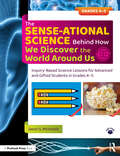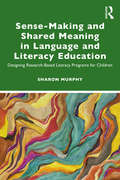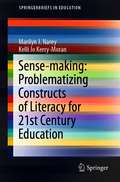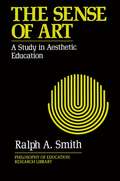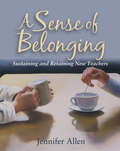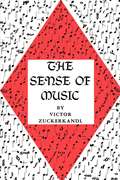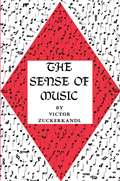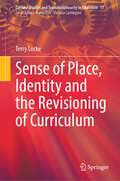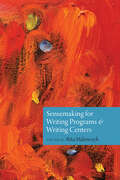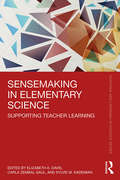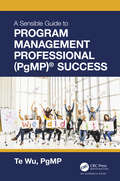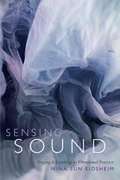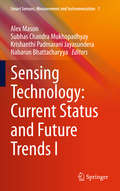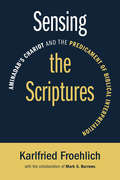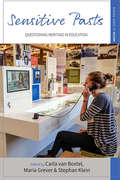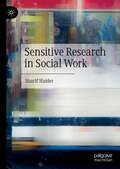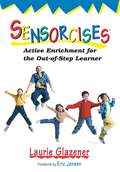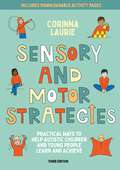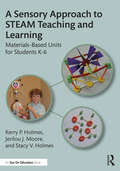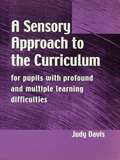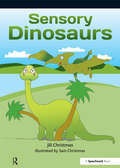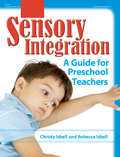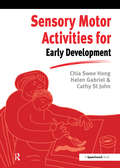- Table View
- List View
The SENSE-ational Science Behind How We Discover the World Around Us: Inquiry-Based Science Lessons for Advanced and Gifted Students in Grades 4-5
by Jason S. McIntoshEmbark on a journey of discovery by connecting with the five senses in this 30-lesson interdisciplinary science unit geared toward the fourth and fifth grade. Students will use their senses as a springboard to explore advanced concepts such as the science behind cooking, optical illusions, musical instruments, and more. They will learn to distinguish between physical and chemical changes, describe the movement of sound waves, classify optical illusions, and evaluate the validity of their discoveries through unique problem-based learning tasks. Featuring detailed teacher instructions, daily reflection activities, and reproducible handouts, this unit makes it easy for teachers to adjust the rigor of learning tasks based on students’ interests and needs. Aligned with Common Core State Standards for English Language Arts and Mathematics and Next Generation Science Standards, both gifted and non-gifted teachers alike will find this unit engaging, effective, and highly adaptable.
Sense-Making and Shared Meaning in Language and Literacy Education: Designing Research-Based Literacy Programs for Children
by Sharon MurphyThis textbook provides a framework for teaching children’s language and literacy and introduces research-based tactics for teachers to use in designing their literacy programs for children. Exploring how sense-making occurs in contemporary literacy practice, Murphy comprehensively covers major topics in literacy, including contemporary multimodal literacy practices, classroom discourse, literacy assessment, language and culture, and teacher knowledge. Organized around themes—talk, reading and composing representation—this book comprehensively invites educators to make sense of their own teaching practices while demonstrating the complexities of how children make sense of and represent meaning in today’s world. Grounded in research, this text features a wealth of real-world, multimodal examples, effective strategies and teaching tactics to apply to any classroom context. Ideal for literacy courses, preservice teachers, teacher educators and literacy scholars, this book illustrates how children become literate in contemporary society and how teachers can create the conditions for children to broaden and deepen their sense-making and expressive efforts.
Sense-making: Problematizing Constructs of Literacy for 21st Century Education (SpringerBriefs in Education)
by Marilyn J. Narey Kelli Jo Kerry-MoranThis book is a rich, yet highly accessible volume that details an exciting and much-needed inquiry into the notion of literacy: what it is, why it is, and how it might be framed most effectively for 21st century education. The chapters unfold in a creative interplay of practice and theory. Narey’s insightful questioning into the socio-historical-cultural implications of “literacy as empowerment” establishes the critical context, while Kerry-Moran’s examination of the burgeoning literacy landscape reveals challenges for teacher education. Drawing upon classic and cutting-edge theories, Narey builds a provocative and powerful case for a 21st century construct of literacy as sense-making: sense as relative to the senses (i.e., sight, hearing) and sense as making meaning. Her innovative model of the literacy event opens up a range of potential foci for analysis and facilitates her teasing out of two critical areas for instruction: sensory perception and aesthetic knowledge. This theoretical sense-making lens is applied to Kerry-Moran’s teacher education classroom as the authors reflect upon further development. As a timely original and thought-provoking work, this slim volume of big ideas promises to be a valuable resource for teacher educators and other scholars who seek a clear and cohesive frame for literacy in 21st century education. This is a very well written scholarly text that provides a new and important theory of 21st century literacy. Narey’s sketches of literacy as sense-making are laid out in logical form, building upon researched and referenced sources to ground her ideas and offering the reader information, examples and new insights. In addition to providing many significant perspectives underpinning her new theory, Narey provides excellent historical and current explanations about literacy from highly respected researchers in the field. The inclusion of a practical application of Narey’s conceptual/theoretical framework to Kerry-Moran's example of an instructional unit in a teacher education course is helpful to understanding the theory in practice. The references throughout the work are extensive, comprehensive and very well documented. This text, Sense-making: Problematizing Constructs of Literacy for 21st Century Education, contributes original thinking to the field of literacy and learning and would be an excellent resource for literacy and language professors or instructors in a post-graduate or professional development program.Penny Silvers, Professor of Education, Dominican University, USA
The Sense of Art: A Study in Aesthetic Education (Philosophy of Education Research Library)
by Ralph A. SmithRalph A. Smith provides a theory of aesthetic education that addresses the need to revitalize the capacity for genuine judgment in society, reaffirm the ideal of excellence in culture, and reorder our thoughts about teaching the arts in schools. The book presents an image of the curriculum as itinerary, preparing the young to traverse the world of art with adroitness and sensitivity.
A Sense of Belonging: Sustaining and Retaining New Teachers
by Jennifer AllenToo often, new teachers enter the profession excited to make a difference in the lives of children only to find themselves disillusioned and overwhelmed with the expectations of the classroom. In A Sense of Belonging, Jennifer Allen shares her stories and journey in creating an infrastructure of support for new teachers within her school district. A Sense of Belonging provides research-based, practical ideas on how to support new teachers while honoring the innovation, idealism, and optimistic enthusiasm that they bring to the classroom. From supporting new teachers early in the year with administering and analyzing literacy assessments, through using student work to guide instruction, to offering ongoing help with curriculum planning, Jennifer shares strategies on:, fostering relationships with new teachers, starting before school even begins;, creating learning environments for new teachers to be reflective practitioners;, coaching new teachers in their classrooms and providing opportunities for them to observe their peers in action;, supporting new teachers beyond their first year through gradual release of support over their first several years in the classroom; and, facilitating professional development opportunities where new and veteran teachers learn alongside one another. Jennifer believes, and her book demonstrates, that when schools embrace, encourage, and celebrate the work of new teachers, they establish a supportive environment that fosters excellence and improves retention.
The Sense of Music
by Victor ZuckerkandlThis book is addressed to the listener whose enjoyment of music is filled with questions and whose curiosity makes him eager to grasp the sense of music, despite a lack of theoretical training. Unlike the usual listener's guide, which begins with a discussion of the elementary materials of music, this book starts with the elementary experiences of listening.
The Sense of Music
by Victor ZuckerkandlThis book is addressed to the listener whose enjoyment of music is filled with questions and whose curiosity makes him eager to grasp the sense of music, despite a lack of theoretical training. Unlike the usual listener's guide, which begins with a discussion of the elementary materials of music, this book starts with the elementary experiences of listening.
Sense of Place, Identity and the Revisioning of Curriculum (Cultural Studies and Transdisciplinarity in Education #17)
by Terry LockeThis book explores intersections between sense of place, the formation of identity, indigeneity and colonisation, literature and literary study, the arts, and a revisioned school curriculum for the Anthropocene. Underpinning the book is a conviction that sense of place is central to the fostering of the change of heart required to secure the survival of human life on earth. It offers a coherent overview of seemingly disparate realities on a geographically and historically sprawling canvas. The book is a work of literary non-fiction, drawing on a range of sources: literary works and criticism, theoretical research, empirical studies and artworks. Of its very nature, the book enacts an extensive cultural critique. After establishing a cross-disciplinary foundation for “sense of place”, the book describes its relationship to identity with reference to such terms as attachment, dispossession, reclamation and representation. It shows how a hopeful narrative for planet stewardship can be developed by the uptake of indigenous and traditional discourses of place. It concludes with the envisioning of a place-conscious curriculum, and ways in which an activist agenda might be pursued in the Anthropocene.
Sensemaking for Writing Programs and Writing Centers
by Rita MalenczykIn this collection writing program and writing center administrators from a range of academic institutions come together to explore their work through the lens of sensemaking. Sensemaking is an organizational theory concept that enables institutions, supervisors, teachers, tutors, and others to better understand the work they do by using narrative, metaphor, and other theoretical lenses. The book is divided into two sections: Sensemaking with Tutors and Teachers, and Sensemaking and Institutional Structures. Chapter authors employ several theoretical approaches to sensemaking, ranging from individual experience to institutional history to document design, providing readers with ideas for how to administer and teach within their programs more effectively; how to advocate for their programs within larger university contexts; and how to positively influence the lives and careers of those they work with. Sensemaking for Writing Programs and Writing Centers theorizes daily experiences from working lives and suggests problem-solving strategies. Writing program administrators, writing department chairs, and writing center directors, tutors, and staff will find value in its pages.
Sensemaking in Elementary Science: Supporting Teacher Learning (Teaching and Learning in Science Series)
by Elizabeth A. Davis Carla Zembal-Saul Sylvie M. KademianGrounded in empirical research, this book offers concrete pathways to direct attention towards elementary science teaching that privileges sensemaking, rather than isolated activities and vocabulary. Outlining a clear vision for this shift using research-backed tools, pedagogies, and practices to support teacher learning and development, this edited volume reveals how teachers can best engage in teaching that supports meaningful learning and understanding in elementary science classrooms. Divided into three sections, this book demonstrates the skills, knowledge bases, and research-driven practices necessary to make a fundamental shift towards a focus on students’ ideas and reasoning, and covers topics such as: An introduction to sensemaking in elementary science; Positioning students at the center of sensemaking; Planning and enacting investigation-based science discussions; Designing a practice-based elementary teacher education program; Reflections on science teacher education and professional development for reform-based elementary science. In line with current reform efforts, including the Next Generation Science Standards (NGSS), Sensemaking in Elementary Science is the perfect resource for graduate students and researchers in science education, elementary education, teacher education, and STEM education looking to explore effective practice, approaches, and development within the elementary science classroom.
The Sensible Guide to Program Management Professional (PgMP)® Success
by Te WuA Sensible Guide to Program Management Professional (PgMP)® Success is for program managers preparing to take the PgMP exam based on The Standard for Program Management – 4th Edition (PgM4 Standard). It is designed for busy professionals whose responsibilities have taken them into the realm of coordinating, facilitating, managing, and leading programs. Program managers are leaders who are directly managing large amounts of project resources for their organizations. This study guide addresses three main concerns facing PgMP exam candidates: What are the essential concepts, processes, and tools that form the foundation of today’s program management? Since program management is still an emerging profession with professionals often working in different ways, what does this mean for a "standard" exam? More specifically, how does that impact your ability to pass the PgMP exam? What is the best way to prepare for the PgMP exam? To address the first concern, this book highlights the underlying rationale for program management: why it exists in organizations; why it is becoming ever more important; what programs are, especially for the purpose of passing the exam; how to think like a portfolio manager; and what the most important concepts, processes, and tools are for this profession. By simplifying complex ideas and communicating them in plain English with relevant examples, this book aims to help readers not only to pass the PgMP exam but also to serve as an essential guide for program managers. For the second concern, this book differs from other study guides by describing the author’s personal experience as a program manager and addressing the most pressing questions for each of the performance domains in The Standard for Program Management. To address the last concern, this book contains 420 practice questions, access to an online exam simulator and an online PgMP community, and a time-tested approach for passing the PgMP exam.
Sensing Sound: Singing and Listening as Vibrational Practice
by Nina Sun EidsheimIn Sensing Sound Nina Sun Eidsheim offers a vibrational theory of music that radically re-envisions how we think about sound, music, and listening. Eidsheim shows how sound, music, and listening are dynamic and contextually dependent, rather than being fixed, knowable, and constant. She uses twenty-first-century operas by Juliana Snapper, Meredith Monk, Christopher Cerrone, and Alba Triana as case studies to challenge common assumptions about sound--such as air being the default medium through which it travels--and to demonstrate the importance a performance's location and reception play in its contingency. By theorizing the voice as an object of knowledge and rejecting the notion of an a priori definition of sound, Eidsheim releases the voice from a constraining set of fixed concepts and meanings. In Eidsheim's theory, music consists of aural, tactile, spatial, physical, material, and vibrational sensations. This expanded definition of music as manifested through material and personal relations suggests that we are all connected to each other in and through sound. Sensing Sound will appeal to readers interested in sound studies, new musicology, contemporary opera, and performance studies.
Sensing Technology: Current Status and Future Trends II
by Nabarun Bhattacharyya Krishanthi Padmarani Jayasundera Subhas Chandra Mukhopadhyay Alex MasonThis book is written for academic and industry professionals working in the field of sensing, instrumentation and related fields, and is positioned to give a snapshot of the current state of the art in sensing technology, particularly from the applied perspective. The book is intended to give broad overview of the latest developments, in addition to discussing the process through which researchers go through in order to develop sensors, or related systems, which will become more widespread in the future.
Sensing the Scriptures: Aminadab's Chariot and the Predicament of Biblical Interpretation
by Karlfried FroehlichThis book explores the ways that Christians, from the period of late antiquity through the Protestant Reformation, interpreted the Bible according to its several levels of meaning. Using the five bodily senses as an organizing principle, Karlfried Froehlich probes key theological developments, traditions, and approaches across this broad period, culminating in a consideration of the implications of this historical development for the contemporary church.Distinguishing between "principles" and "rules" of interpretation, Froehlich offers a clear and useful way of discerning the fundamental difference between interpretive methods (rules) and the overarching spiritual goals (principles) that must guide biblical interpretation. As a study of roots and reasons as well as the role of imagination in the development of biblical interpretation, Sensing the Scriptures reminds us how intellectually and spiritually relevant the pursuit of a historical perspective is for Christian faith and life today.
Sensitive Pasts: Questioning Heritage in Education (Making Sense of History #27)
by Carla Van Boxtel Maria Grever Stephan KleinHeritage, as an area of research and learning, often deals with difficult historical questions, due to the strong emotions and political commitments that are often at stake. In this, it poses particular challenges for teachers, museum educators and the publics they serve. Guided by a shared focus on these “sensitive pasts,” the contributors to this volume draw on new theoretical and empirical research to provide valuable insights into heritage pedagogy. Together they demonstrate the potential of heritage as a historical-educational domain that transcends myopic patriotism, parochialism and simplistic relativism, helping to enhance critical and sophisticated historical thinking.
Sensitive Research in Social Work
by Sharif HaiderThis book addresses issues related with researching sensitive topics in social work, focusing on marginalized, vulnerable and hard to reach people. It covers the definition, characteristics, challenges and opportunities of sensitive research, its philosophical roots and methodological debates, and the skills and values that are required along with the ethical, political and legal issues involved in conducting social work research. This book will cover innovative research methods appropriate for research on sensitive topics involving vulnerable people. It shines light on how to use traditional research methods sensitively, and how to generate data while minimizing the harm that can potentially be caused to research participants and researchers.
Sensorcises: Active Enrichment for the Out-of-Step Learner
by Laurie GlazenerGet moving to prime the body for learning!All young students sometimes need a little extra help developing their senses. And many kids who are labeled as "problem students" simply lack the physical skills necessary to sit still, pay attention or even hold a pencil. Sensorcises helps students develop the very basic sensory skills needed for learning. Learn how to address the needs of these learners and help them develop the sensory motor skills they need to succeed.In this invigorating book, the author explores the REAL technique-Relax, Energize, Activate and Lead. By providing clear, step-by-step instructions, this book shows you how to design activity sequences to help students with sensory dysfunction as well as all the other learners in your K-5 classes. The author makes it incredibly easy to incorporate these exercises into any curriculum. Each research-based activity is fully described and illustrated with photographs to assist with classroom implementation.You AND your whole class will benefit from Sensorcises! They are the perfect way to boost energy levels while helping students focus their mind, body, and senses on achieving success.
Sensory and Motor Strategies (3rd edition): Practical Ways to Help Autistic Children and Young People Learn and Achieve
by Corinna LaurieIn this fully revised third edition, Corinna Laurie sets out practical strategies to help autistic children develop their sensory and motor skills. Learn to identify possible challenges, recognise signs of overload and work in a co-productive way with your student or child, developing sensory regulation strategies and improving motor skills to aid well-being.The simple, low-cost activities provide practical solutions to help children meet the demands of any situation, building skills from handwriting and using scissors to improving posture, co-ordination and motor planning. Sensory strategies include calming techniques and simple environmental modifications to prevent overwhelm, among many others.Helping to improve functional abilities and enable children to thrive and build independence, this is an essential resource for anyone working with children on the autism spectrum.
A Sensory Approach to STEAM Teaching and Learning: Materials-Based Units for Students K-6
by Kerry P. Holmes Jerilou J. Moore Stacy V. HolmesDid you know you have the power and the materials at your fingertips to facilitate the actual brain growth of students? This book is a practical resource to engage K-6 students with STEAM content through their five senses: seeing, listening, touch/movement, smell and taste. It combines historical research, practical suggestions, and current practices on the stages of cognitive development and the brain’s physical response to emotion and novelty; to help you learn ways to transform ordinary lesson plans into novel and exciting opportunities for students to learn through instruction, exploration, inquiry, and discovery. In addition to providing examples of sensory-rich unit plans, the authors take you through the step-by-step process on how to plan a thematic unit and break it down into daily seamless lesson plans that integrate science, technology, engineering, arts, and mathematics. With 25 themed STEAM unit plans and activities based on national standards, up-to-date research on brain science, and real classroom experience, this book shows multiple ways to develop and deliver active multisensory activities and wow your students with sights and sounds as soon as they come through the door of your classroom.
A Sensory Approach to STEAM Teaching and Learning: Materials-Based Units for Students K-6
by Kerry P. Holmes Jerilou J. Moore Stacy V. HolmesDid you know you have the power and the materials at your fingertips to facilitate the actual brain growth of students?This book is a practical resource to engage K-6 students with STEAM content through their five senses: seeing, listening, touch/movement, smell and taste. It combines historical research, practical suggestions, and current practices on the stages of cognitive development and the brain’s physical response to emotion and novelty; to help you learn ways to transform ordinary lesson plans into novel and exciting opportunities for students to learn through instruction, exploration, inquiry, and discovery.In addition to providing examples of sensory-rich unit plans, the authors take you through the step-by-step process on how to plan a thematic unit and break it down into daily seamless lesson plans that integrate science, technology, engineering, arts, and mathematics.With 25 themed STEAM unit plans and activities based on national standards, up-to-date research on brain science, and real classroom experience, this book shows multiple ways to develop and deliver active multisensory activities and wow your students with sights and sounds as soon as they come through the door of your classroom.
A Sensory Approach to the Curriculum: For Pupils with Profound and Multiple Learning Difficulties
by Judy DavisWritten by a teacher with many years of experience with pupils with PMLD, this book offers a well-tried approach to delivering the curriculum, with particular emphasis on the core subjects. It aims to complement and supplement existing material and provides a useful resource for busy teachers.
Sensory-Balance: An Approach to Learning Media Assessment for Students With CVI
by Christine Roman-Lantzy Matthew TietjenThe current leading cause of visual impairment among children is not a disease or condition of the eyes, but cortical visual impairment (CVI)-also known as cerebral visual impairment-in which visual dysfunction is caused by damage or injury to the brain. The definition, nature, and treatment of CVI are the focus of great concern and widespread debate, and this complex condition poses challenges to professionals and families seeking to support the growth and development of visually impaired children. On the basis of more than 30 years' experience in working with hundreds of children of all ages with CVI, Christine Roman-Lantzy has developed a set of unique assessment tools and systematic, targeted principles whose use has helped children learn to use their vision more effectively. This one-of-a-kind resource provides readers with both a conceptual framework with which to understand working with CVI and concrete strategies to apply directly in their work.
Sensory Dinosaurs
by Jill ChristmasThis is an engaging and thoroughly well-thought out book that will help teachers, parents, carers and children in understanding why some children struggle in school as a result of sometimes undiagnosed or unrecognised challenges. A short description of a sensory/motor condition precedes each story - the challenges faced described through a variety of dinosaur characters. The story is followed up with a worksheet for the child and supporting adult to work through, and there are practical strategies recommended for both school and home. Each dinosaur has a different sensory condition, for example, Terri-dactyl who is afraid of heights and flying because his balance system is very sensitive and he can't join in with his friends because of his difficulties. Other dinosaurs and their conditions include: Developmental Coordination Disorder; Dyspraxia/proprioception; Sensory processing/Sensory Integration Disorder; Asperger's syndrome; Self Esteem Issues; Joint hypermobility; Dyslexia; and, Balance difficulties. The strategies are advisory only but simple and practical enough to be incorporated within a school or home setting with the minimum of cost. "Sensory Dinosaurs" provides an excellent platform for positive participation by the child in exploring the challenges they personally experience.
Sensory Integration: A Guide for Preschool Teachers
by Rebecca Isbell Christy IsbellDo you have a child in your early childhood classroom who:*Climbs on top of furniture and jumps off? *Covers his ears when children are singing? *Refuses to touch clay, paint, or sand? *Often falls down and skins her knees? *Refuses to play on outdoor playground equipment?If so, it is possible the child is having sensory processing problems. How can you help children with these problems so they can enjoy learning and grow in positive ways? Sensory Integration helps you identify children who have difficulties with sensory processing, and it offers simple, easy-to-use solutions to support the sensory needs of young children in the preschool classroom. Easy-to-implement solutions include adaptations and activities for children with different types of Sensory Processing Disorder. This book has a bonus chapter with instructions for creating low-cost items to help children with sensory issues.Chapters cover concepts such as:*Explaining Sensory Integration and Sensory Processing Disorder*Defining sensory avoiders, seekers, and under-responders*Designing the environment to support the sensory development of all children*Helping preschoolers with sensory processing problems*Providing practical solutions to meet the needs of individual children during daily routines*Building and creating low-cost items such as a tire swing, sand pillow, and incline board to give children opportunities to get the sensory input they need
Sensory Motor Activities for Early Development: A Practical Resource
by Chia Swee Hong Helen GabrielThis is a successful manual of tried and tested activities to develop gross and fine motor skills in children. It contains: Numerous creative activities to stimulate sensory and body awareness, encourage basic movement, promote hand skills and enhance spatial/perceptual skills; Information on working in small groups; Handouts that can be photocopied to give to parents or other carers for home practice.
